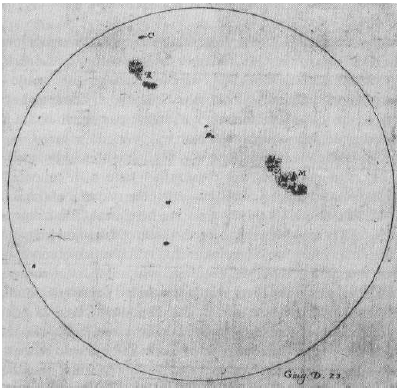Sunspots: A brief history (Part 1 of 2)
Special contribution by Paul Charbonneau of the Department of Physics, Université de Montréal
Since the Sun is so close to us, one might suppose that astronomers had figured out most of its secrets. But this is not so: each new instrument we point at our local star raises new questions.
In 1609, Galileo developed an astronomical telescope. For the next three years, his amazing instrument revealed many dark spots on the Sun's surface. This was contrary to the doctrine of the period, which held that the Sun was immaculate.

Galileo drew these sunspots on June 23, 1612. There is a very clear demarcation between the umbra and penumbra, and also between the penumbra and the atmosphere.
Spots, not shadows
Young Johann Fabricius' observations from the same period went still further. After observing day-to-day movement of the spots over the Sun's surface, he concluded that the Sun rotates on its own axis. Others thought the spots were merely the shadows of planets orbiting near the Sun, but, after analyzing their shapes, Galileo quickly refuted this argument. If the spots had been shadows of planets, they should have been almost perfectly circular. Instead, he showed, they have irregular, variable shapes.
Changing spots
Christoph Scheiner, another contemporary of Galileo, proved the hypothesis of Fabricius and Galileo, that the Sun rotates on an axis slightly tilted relative to the plane of the Earth's orbit. The cause of sunspots, however, remained a mystery. Since the spots change shape and appearance unpredictably, Galileo thought they might be a kind of cloud in the solar atmosphere.
There was intense speculation over the next three centuries. Sunspots were sometimes described as dark mountains jutting up through the atmosphere, or as holes in the Sun's luminous atmosphere through which its dark, cold surface can be seen. Some influential astronomers, including William Herschel, even thought the Sun might be inhabited.

Each of these sunspots is 13 times the area of the Earth's surface. (Credit: SOHO)

A drawing by astronomer Christoph Scheiner illustrating the trajectories of two large sunspots crossing the solar disc six months apart.
Controversial observations
The observations of Galileo, Fabricius, and Scheiner contradicted dogmas of physics based on Aristotle—widely accepted at the time—which held that heavenly bodies were immutable and moved along perfectly circular paths.
Sunspots began as mere astronomical curiosities, but quickly became the heart of a debate on the structure of the universe. The new theories defied geocentric doctrine that depicts Earth at the centre of the universe in favour of a heliocentric cosmology where planets orbit the Sun—an idea originally conceived by the ancient Greeks and revived by Copernicus in the middle of the 16th century.
Explore further
- Date modified: